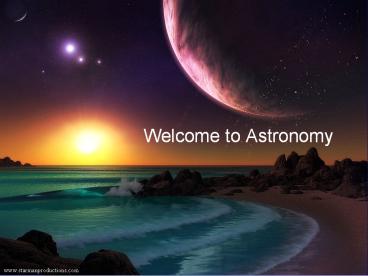www.starmanproductions.com - PowerPoint PPT Presentation
1 / 13
Title:
www.starmanproductions.com
Description:
To learn how the interaction of the Sun, Moon, and Earth ... (Astrology a popular pseudoscience!) ...and new technology is always evolving. Telescopes ... – PowerPoint PPT presentation
Number of Views:336
Avg rating:3.0/5.0
Title: www.starmanproductions.com
1
Welcome to Astronomy
www.starmanproductions.com
2
Why Do We Study Space?
3
Why Will We Study Space?
- To understand how our entire concept of time is
based on astrological cycles. - To learn how the interaction of the Sun, Moon,
and Earth affects our daily lives. - To apply what we learned about physics to
- Optics and the Tools of Astronomy
- Planetary Motion and Orbits
- The Planets, Solar System and Galaxies
4
History of Astronomy
- Also see History of Astronomy worksheet
- The Greeks were the first to study the sky in a
scientific way - Names to know
- Copernicus
- Ptolemy
- Tycho Brahe
- Kepler
- Galileo
- Edwin Hubble
5
Extra Credit Test Questions!
- Learn and understand the difference between the
geocentric and heliocentric models of the solar
system. - Learn and understand the concept of Retrograde
orbits/motion.
6
What the Ancients Knew
- Ancient civilizations (yes, including those
Doomsday Mayans!) matched clues from the sky to
what they observed on Earth - Day/night cycle (circadian rhythms)
- Changing seasons and length of day
- Growth cycles of crops
- Birth cycles of livestock and game
- Human gestation cycles
7
Ancient Tools
- Ancient Greek Temples
- The Great Pyramids of Egypt
- Mayan pyramid El Castillo
- Stonehenge
- Big Horn Medicine Wheel
- Many, many others worldwide!
- Their locations/orientations aligned with
celestial events! Think massive calendars
8
Lasting Tools?
- Sundials
- Clocks
- Calendars
- The Symbols of the Zodiac (Astrology a popular
pseudoscience!) - and new technology is always evolving
- Telescopes
- Space Probes
- Manned space vehicles
9
Learn these terms!
- Celestial Body A moon, planet or star
- Rotation When a celestial body spins on its
axis - Earth completes one rotation in 23 hrs 56 min
- Revolution When a celestial body orbits around
another celestial body - Earth completes one revolution in 365.25 days
10
Days (think Rotation)
- Until 5000 years ago, people were happy with
day and night There was no formal timekeeping. - Days were first divided into hours using the
suns shadows on sundials or obelisks,but that
didnt work at night. - Water clocks solved the daylight problem today
clocks use the vibrations of quartz, the motion
of pendulums, and even the oscillation of atoms).
11
Months (think Revolution)
- One month is approximately the time it takes the
moon to complete one lunar cycle or one
revolution around Earth (29.5 days). - The Greeks made some adjustments so our calendar
year matches the 365.25 days it takes the Earth
to revolve around the sun.
12
Introduction to the Lunar Cycle
- The half of the Moon facing the Sun is always
lit, but the lit side does not always face the
Earth! As the Moon circles the Earth, the amount
of the lit side we see changes.
13
Introduction to the Lunar Cycle































